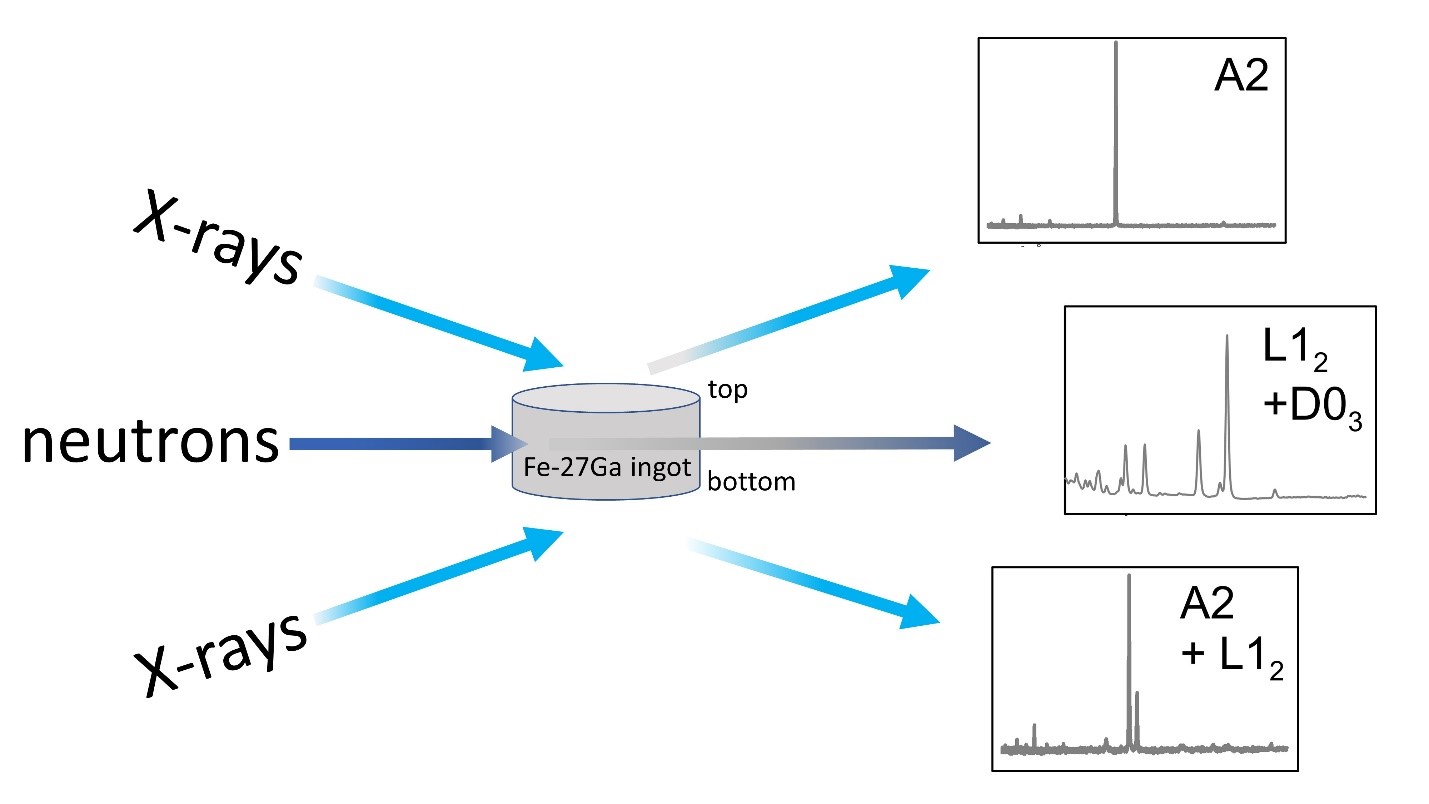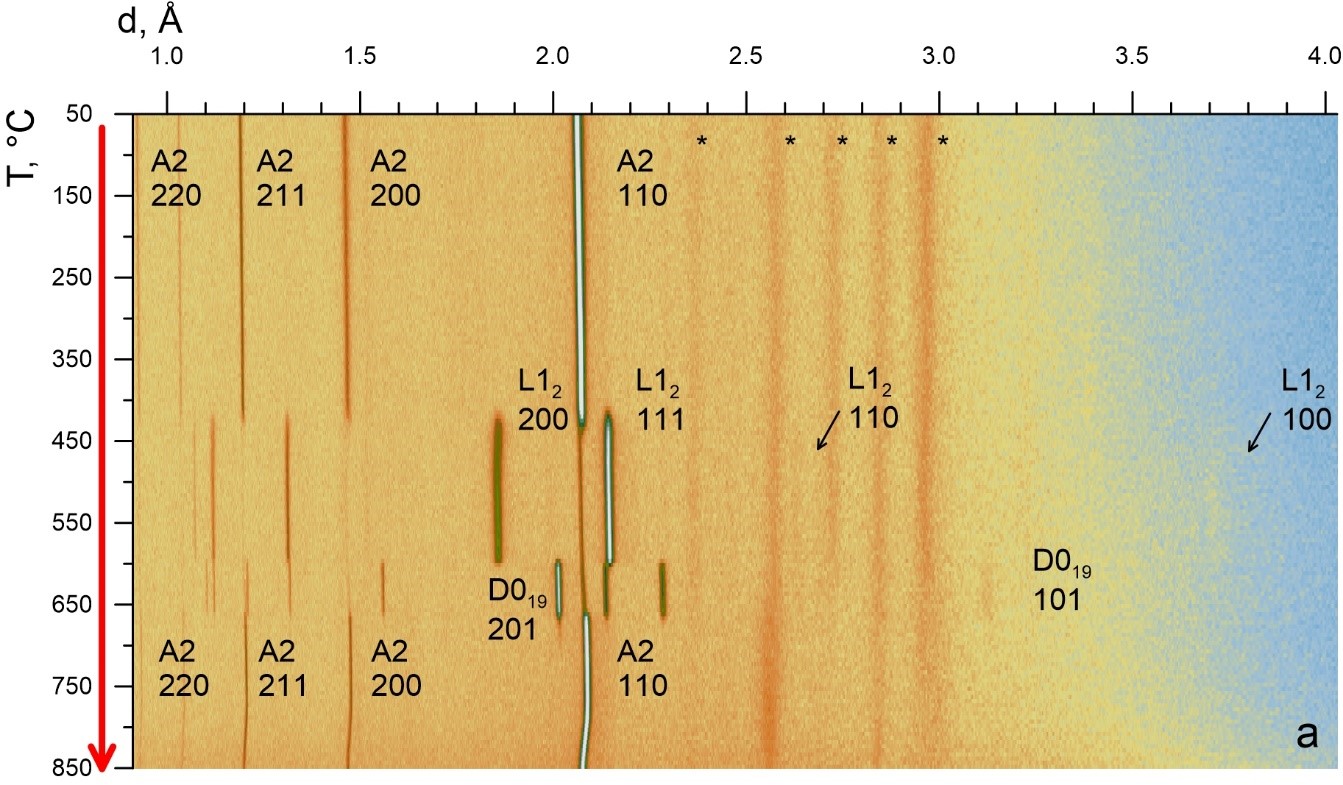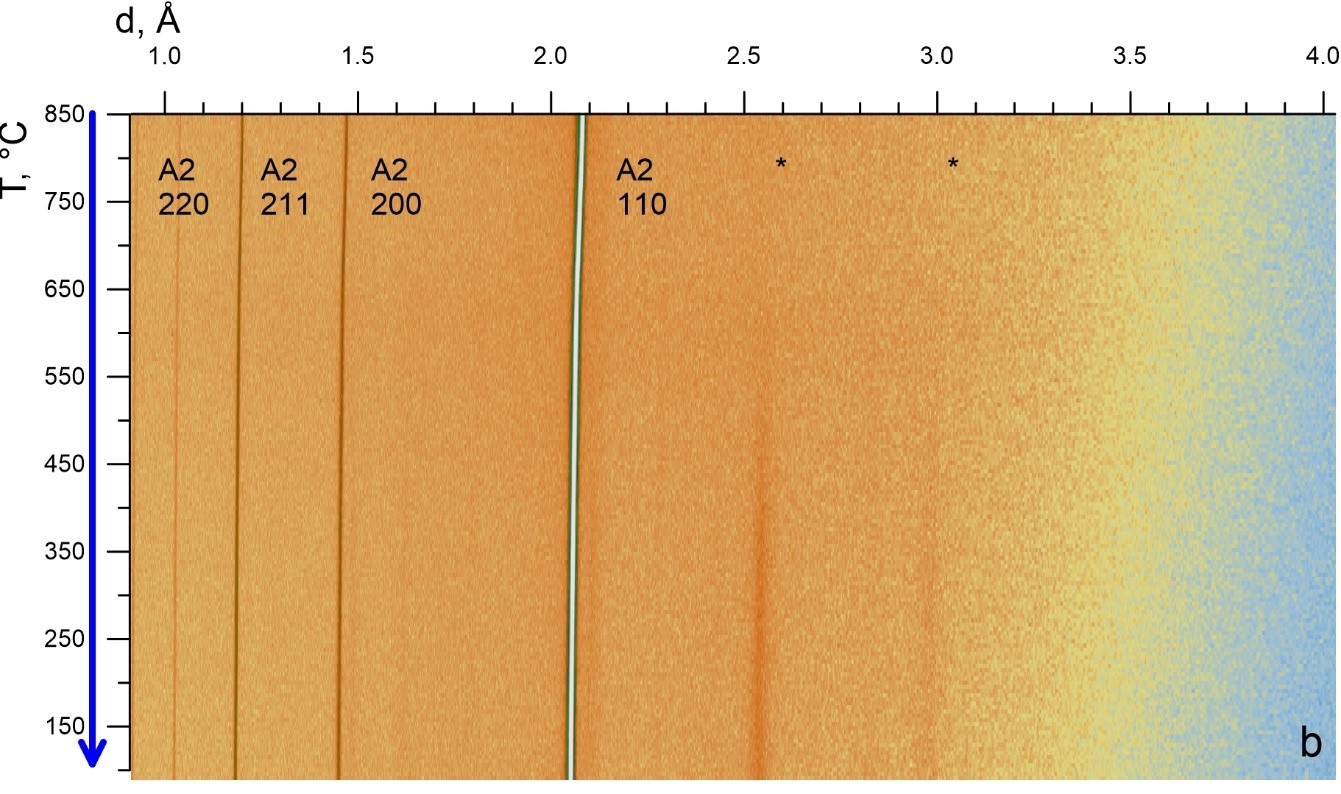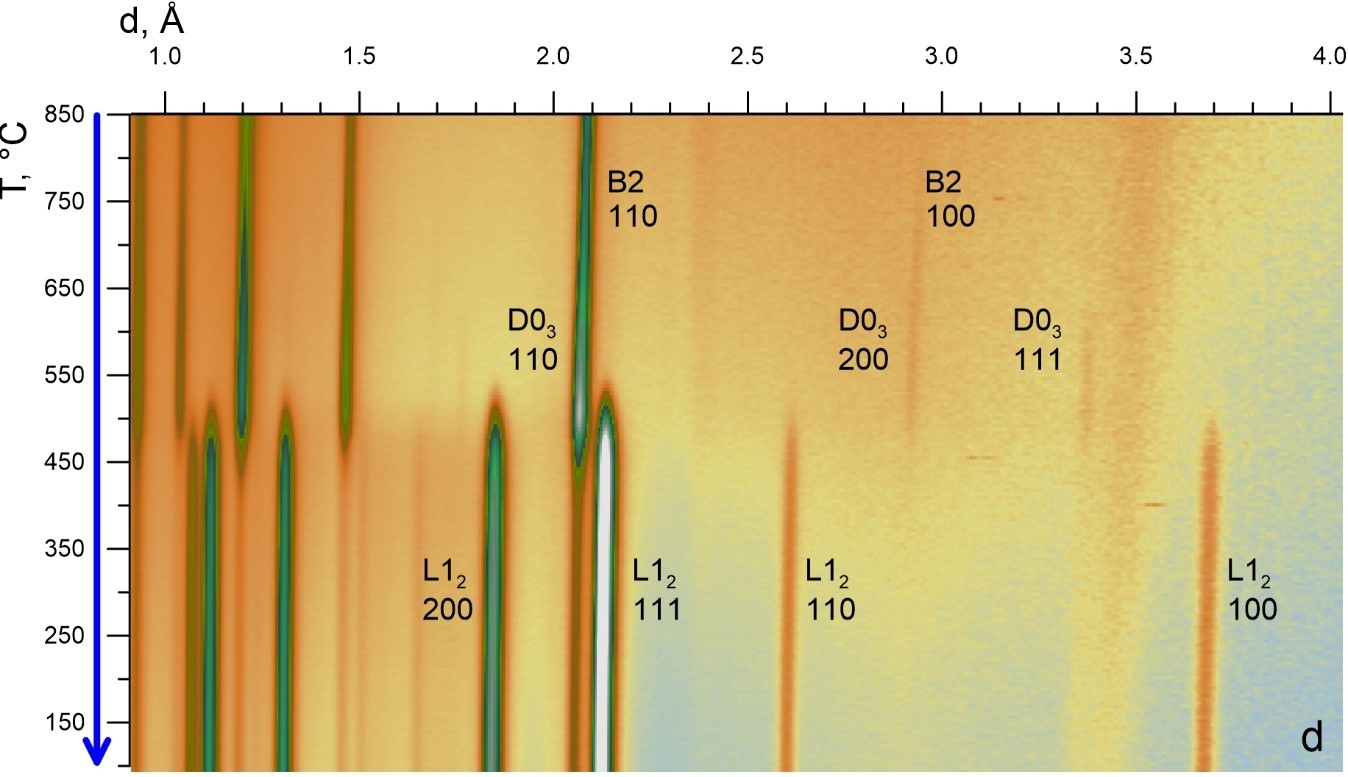Studies by researchers from the Frank Laboratory of Neutron Physics of JINR reveal the relationships between the structural features and macroscopic properties of smart iron-gallium alloys (galfenol). Comparative X-ray and neutron diffraction experiments help researchers to move forward in obtaining alloys with the desired properties and demonstrate the advantages of neutrons over X-rays in studies of these metallic systems.

Galfenol
Intermetallic compounds are functional materials, whose mechanical and physical properties are largely determined by their specific atomic structure, volume content of different structural phases and microstructural state. Intermetallic alloys of the iron-gallium (Fe-xGa) system have pronounced magnetic and mechanical properties and are known for their exceptional magnetostriction compared to other binary iron-based alloys. Materials with such properties can significantly change their shape and dimensions during the process of magnetization/demagnetization, which was first observed by James Joule in 1842. (The magnetostrictive effect caused by a change in the energy state of a material when subjected to a magnetic field, is used to convert electromagnetic energy into mechanical energy. The inverse magnetostrictive effect, magnetoelastic effect or Villari effect is the change of the magnetic susceptibility of a material when subjected to a mechanical stress.)
This property of Fe-Ga alloys has attracted much attention for more than half a century, and has experienced a significant upsurge in interest in the last 20 years following the development of galfenol at the U.S. Naval Ordnance Laboratory (Gal for gallium, Fe for iron, NOL for Naval Ordnance Laboratory).
Galfenol is a magnetostrictive, mechanically robust and highly sensitive to external fields and deformations material with a favourable combination of functional and mechanical properties, which are best exhibited at a Ga content of 19 or 27% (In this case, the magnetostriction value in a single crystal at room temperature reaches 400-350 ppm and is determined not only by the composition of the alloy, but also depends on the method of its preparation, and on the presence of impurities.). It is already widely used in high-tech industries and has great potential for use as highly sensitive sensors, transducers, magnetostrictive actuators, powerful sonars, energy-harvesting applications and spintronic devices.
The unusual functional properties of galfenol, such as the record magnetostriction value, are associated with inhomogeneities in the material structure. Nevertheless, there are still many unexplored gaps in the research of Fe-Ga alloys, and scientists are trying to explain why micro- and nano-inhomogeneities occur in them and phase transformations take place under different conditions. Answers to these questions will play an important role in the theory of intermetallic compounds and will allow the selection of new compositions of alloys and methods for their production to obtain materials with maximum values for useful properties. In the future, it will open the way to the application of such smart materials for energy harvesting.
Energy harvesting: collection of ambient energy using Galfenol or generation of energy out of nothing
Energy harvesting is the process of extracting energy from the surrounding environment, literally out of nothing (for example, from the movement of air and water, from sunlight and from the salinity gradient at river mouths) and converting it into usable electric power to feed miniature sensors of wireless sensor networks, various gadgets, wearable electronics and other autonomous devices that have long entered our lives.
Over the past decade, developers of new energy-harvesting devices that efficiently convert kinetic energy of vibrations into electromagnetic energy have been trying to use galfenol. Compared to traditional ambient energy harvesters, “smart” galfenol collects and converts energy due to the alloy's inherent properties, rather than the relative movement between its components. Therefore, galfenol-based power devices can have higher energy conversion rates at lower frequencies. These properties will make it possible to reduce the weight and volume of the system and facilitate integration with other devices. Galfenol is a ductile material that can withstand extreme temperature changes and is not damaged by welding and multiple vibration cycles. Therefore, it is increasingly being referred to as a favorite among alloys with high magnetostriction, which are used as energy harvesters. The former record holder Terfenol-D with a high content of rare earth elements (Tb0.3Dy0.7Fe2), as well as materials used in piezoelectric elements, are brittle and susceptible to aging.
Studies of the structural features and properties of galfenol will allow us to control the parameters affecting the operation of energy harvesters, and develop new efficient energy harvesting devices.
Neutron and X-ray diffraction
Fig. 1. Scheme of experiments
To find out why the presence of non-magnetic gallium in a certain proportion in iron alloys drastically increases the magnetostriction of galfenol, scientists are trying to obtain additional information about the atomic structure, microstructural states and phase transformations in the material. For this purpose, they use all kinds of materials science methods for studying metals (microscopy, calorimetry and others), as well as in situ neutron and X-ray diffraction techniques.
In the last few years, scientists from the National University of Science and Technology “MISiS” in collaboration with colleagues from FLNP JINR have been exploring the potential of the neutron diffraction technique for revealing regularities between the functional properties of galfenol and its structural peculiarities, using neutron diffractometers at the unique IBR-2 pulsed reactor at JINR.
One more joint study of the scientists published in the Journal of Applied Crystallography focuses on the comparison of the results obtained by X-ray and neutron diffraction methods using identical Fe-27Ga alloy samples under heating up to 850°C and subsequent cooling to room temperature.
The main advantage of X-ray diffraction, including that based on synchrotron radiation, is the possibility of studying the structure of the surface layer of the sample with high resolution, but it does not provide enough information on the structural features and kinetics of processes in the bulk of the sample even with the special preparation of the sample surface and placing the sample under vacuum. At the same time, neutron diffraction is a method, which, due to the high penetrating power of neutrons, allows one to study the formation of inhomogeneities, phase transitions and transformation of the crystal structure in the bulk of the sample.
Fig. 2. 2D evolution of the XRD [(a), (b)] and ND [(c), (d)] patterns during heating [(a), (c)] and cooling [(b), (d)] of Fe–27Ga samples. In (a), asterisks mark the diffraction peaks from a Ga2O3 impurity phase. In (b), asterisks mark the weak diffraction peaks from a Fe2O3 impurity phase.
“The obtained results confirm the well-known fact that X-ray diffraction provides structural information only from the surface of the material (which in itself, of course, is important), whereas neutrons are scattered by the bulk of samples, and therefore neutron studies can significantly complement the structural analysis of bulk samples and refine phase diagrams. The observations made in the neutron and X-ray diffraction experiments revealed that the surface and the bulk of the samples have different structural states and undergo different phase transitions. From a practical point of view, the results of in situ experiments, which show the details of phase transitions during heat treatment of the alloy, are of particular interest. For example, the temperatures for all phase transitions determined from X-ray diffraction experiments were 20° lower than the corresponding phase-transition temperatures in neutron diffraction experiments, which may indicate that a new Fe-Ga phase nucleates on the surface area and grows deeper into the bulk. This information will help to optimize technological processes during alloy preparation,” commented the study's author Ivan Bobrikov, a researcher from the Frank Laboratory of Neutron Physics, JINR.
Temperature evolution of Fe–27Ga structure: comparison of in situ X-ray and neutron diffraction studies. Ivan A. Bobrikov, Nataliya Yu. Samoylova, Sergey V. Sumnikov, Olga Yu. Ivanshina, Ekaterina A. Korneeva, Anatoly M. Balagurov and Igor S. Golovin. J. Appl. Cryst. 2020, V. 53. 1343–1352.
Olga Baklitskaya-Kameneva







